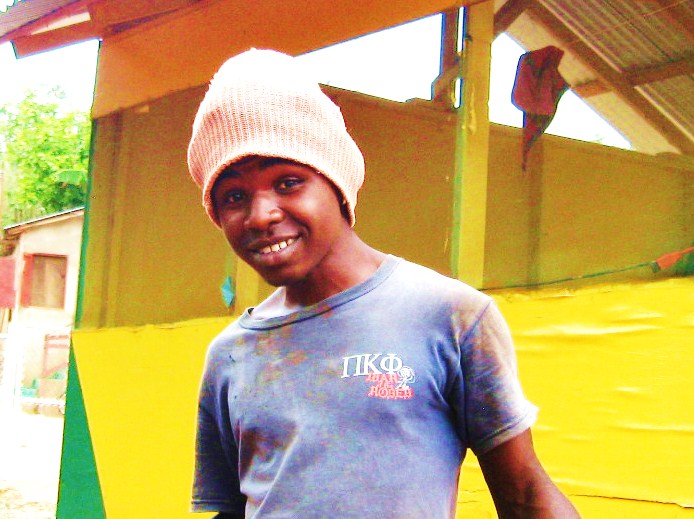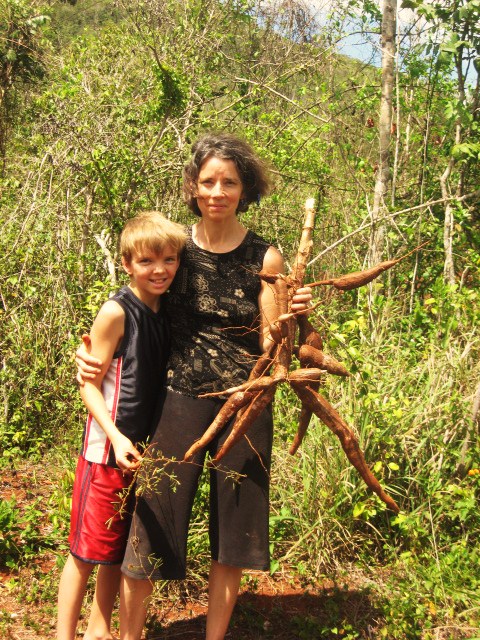|
Pop cans, food covering, and airplane wings all contain one main ingredient, aluminum. Anything that needs to be lightweight, hard and flexible is made from this metal. Where does aluminum come from? How has this metal impacted the community of Harmons? It can be explained with one natural resource: bauxite.
Deep in the heart of Jamaica, the soil is red and has more clay than silt or sand. It is similar to Georgia clay or Virginia soil but there are some differences. The biggest difference is the presence of bauxite, an aluminum hydroxide, which is extracted to make aluminum. Only found in a few countries, bauxite is highly sought after. Jamaica is ranked fourth in bauxite production after Guinea (1st), Australia (2nd) and Vietnam (3rd). Even in Jamaica, it is hard to find a high concentration of it in the red clay. Here, in Harmons, Jamaica (where we are serving God) there are some of the richest bauxite veins in all of Jamaica. It all started in the 1970’s, when a mining company came and tested the soil of Harmons. When finding the soil high in bauxite, they proceeded to buy as much of the valley as they could from the local people. These people (well below the poverty line) were farmers and when they were offered very little money they sold almost immediately thinking that they were making a fortune. The bauxite company promised to build drinking water tanks at each end of Harmons and relocate people whose land they had bought. No mining took place in Harmons until a new generation was born. Approximately four years ago, the bauxite company started mining. This generation of farmers was forced to relocate as the bauxite company tore through the land their parents had sold for almost nothing. The mining created acre upon acre of red muddy canyons through the valley of Harmons. When the global economy fell in 2008, the mining slowly dwindled to what it is today, a trickle of trucks taking the red soil from a few strip mines in the neighborhood. None of the land has been reclaimed and none of the promised water tanks placed in Harmons. Countless people go without water for weeks, collecting off their roofs or carrying water from a government reservoir. A few houses of relocated residents were built, but the vast majority live in tin shacks. Next time you take a drink out of a can, fly on an airplane or cover your food, remember Harmons, Jamaica. The landscape is barren, people are void of a consistent source of water, and homes are unsafe shacks. As consumers of this natural resource, aren’t we responsible to do something? Please consider writing our federal senators, Honorable Toomey and Casey, at www.toomey.gov and www.casey.gov about the aluminum industry. _ When we think of Jamaica, we think of white sand beaches, palm trees and Bob Marley. There is a lot more to this country than cruise ships and honeymoons; it houses a diverse and historically-rich population.
Jamaica’s first inhabitants were believed to be a peaceful people called the Arawaks. Theoretically, they wandered out of Siberia, across the Bering Strait slowly and spreading southward. Arawaks were simple and generous. When Columbus arrived in 1494 on his second voyage, they believed the Spaniards were gods and gave them the little gold they had. They ate little; Ferdinand, Columbus’ son, wrote that that what Spaniards ate in one day would last an Arawak twenty. The Arawaks died out quickly due to the Spanish sport of killing them and also do to contiguous European diseases, mainly smallpox, for which they had no resistance. Eventually the Spanish took control of Jamaica and made it a center of trade from plantations. They made it very profitable and so it was not a surprise when the English attacked the weakly defended island and took control in 1654. As the slave trade in the Greater Antilles grew, Jamaica became a dumping ground for troublesome slaves. Some of these slaves escaped into the cockpit area which is located in the central western part of the island. Its terrain includes rocky crags, cliffs and caves being extremely hard to navigate. These deserting slaves were called Maroons. The Maroons were hostile to outsiders and would frequently attack and burn large plantations. The slaves developed their native language called patois (pronounced paw-twa) so they could talk without the plantation owners. This Jamaican Creole was a dialect of slurred and abbreviated African, Spanish, and English. After years of complaints, England sent its army to dispose of the Maroons. The English were familiar with fighting in open fields, in straight lines and with laws of war. They marched up through the cliffs beating drums and wearing bright red coats expecting meet the Maroons in the open and face to face. Two words describe Maroon war tactics: ambush and camouflage. They surrounded the English and quickly defeated them. In 1838 the slaves were emancipated and in 1962 Jamaica gained its independence from England. Through peace and strife, many people reside in Jamaica. Beautifully adorn in dark chocolate and flamboyant dialect, they are community-based, mischievous, hardworking, rebellious if taunted, and strong hearted. That is why the national motto “Out of many people, one” _In America, sustainability in farming is not predominately practiced due to the prevalence of factory farms. Corporations dictate to a farmer to plant a seed into the ground, which has been altered and genetically enhanced in the laboratory. The farmer dumps gallons of toxic chemicals on the plant as it matures with the intent to kill the "bad" insects or weeds, but ultimately an entire ecosystem is destroyed. After that monoculture fruits, it is sold to huge commercial food organizations. They in turn take the raw product processing it into hundreds of foods adding artificial colors and flavors, synthetic preservatives, synthetic sweeteners, and hydrogenated oils (all of which are harmful to your body). They sell this product to the uninformed consumers and wrap it in plastic which may leach xeno-estrogens (known to cause cancer) into its contents and consumer. There are so many complications in growing, harvesting, and eating factory farmed, processed products that are harmful and unnecessary. How did our ancestors farm successfully without any modern technologies? Let me tell you a story to explain.
"Hey Crusty," calls Byron to my dad as our family walks up out to meet him. Byron is a Jamaican farmer who lives down the road from us. He calls my dad, Rusty, "Crusty" as a pet-name (nickname). We are heading to his farm to buy cassava, which is kind of like a potato. That night Channakay will teach us how to make bammy, a fluffy pancake, with Jamaica’s number one carbohydrate. Around the world many eat tapioca made from cassava. We walk down the road and follow him up a well-worn path to a savannah- like plain. The mountains rise before us and the hot sun's rays burn our shoulders. When we make it to his farm, it doesn't look very spectacular. Rows of small trees no higher than your head with green and purple compound leaves are planted in rows of raised beds. Byron explains that these are cassava plants. He walks over and yanks one up exposing the potato-like tubers connected to the central stem. With his machete, he chops them off and hands them to my mom. My dad asks where he got his seeds, but Byron only chuckles. He takes the cassava stem and cuts off a three foot stick from the trunk. He then sticks it in the ground. He looks at us and says that it will grow into a new plant. Perennial yams, sweet potatoes, and pineapples grow productively. My mom hands him a pineapple top she had bought earlier to help continue his sustainable cycle. We are amazed at how sustainable his growing techniques are. He never has to buy seeds and he never uses imported, petroleum-based fertilizer. He proudly states that he does not spray his plants and when he sells his crop there is no need for extra packaging. He knows how to sustainably grow and harvest food so his customers are knowledgeable about their sustenance. |
AuthorWalker Orner, son of Rusty and Claire Orner Archives
August 2012
Categories |







 RSS Feed
RSS Feed
